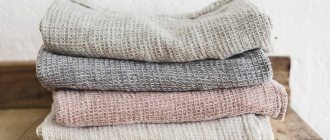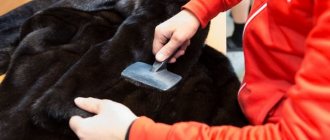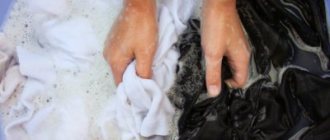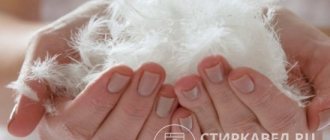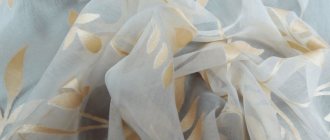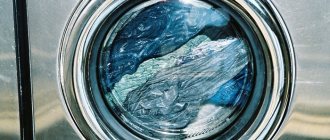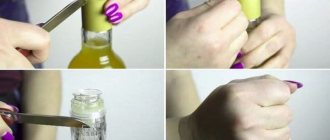Neoprene is a synthetic rubber that has a wide range of applications. Thus, the fabric is used to make clothing, cases for phones, tablets or laptops, for medical and industrial devices. This is a very dense and elastic material that fixes the correct position of the body.
Therefore, neoprene is often used for the manufacture of orthopedic products. In addition, it is waterproof and suitable for sewing wetsuits, diving suits, coats and outerwear for rainy weather.
Today, neoprene has firmly entered modern life, and sports and casual clothing are made from this material. Things made of neoprene are very convenient, comfortable, and safe. In addition, they are unpretentious in care.
Products do not need to be ironed, but sometimes they need to be washed or cleaned. Moreover, this must be done extremely carefully and in compliance with a number of recommendations. Let's figure out how to properly care for this material so that it retains its original appearance.
Features of neoprene products
Neoprene is a very durable and excellent heat-retaining fabric.
The proposed type of material involves a unique foam fabric that has an interesting porous structure; it is synthetic rubber.
The front part of neoprene products (socks, trousers, top, gloves, tracksuit) is covered with a special polymer. The back is quite pleasant to the body, as it is lined with viscose, cotton, and polyester.
The fabric is actively used in the following areas: sports, medicine, industry, and the manufacture of consumer goods.
The washing procedure and specific care system are related to the area in which they are used. Neoprene is mainly used to make stylish and comfortable outerwear (cardigans, coats), skirts and shorts, as well as diving suits.
It’s easy to wash the products, you should remember that this is a durable and very durable fabric that retains heat, provides comfortable wearing and does not even wrinkle.
There is increased resistance to the influence of sunlight, moisture, temperature changes, and frost. The material is considered environmentally friendly and does not provoke allergic reactions.
Application of material
- For lovers of underwater adventures, wetsuits made from this rubber (type HS) are incredibly durable and keep a person warm.
- In the automotive industry - tubes, hoses, rings. Products made from this material (type HHS) reduce vibration and noise. And car seat covers have the longest service life. The construction industry produces roofing materials, sheaths for various cables, etc.
- In the medical field (W type): bandages, overalls, various shoes, etc.
- For sports and tourism enthusiasts (HS type), they produce coverings for sports equipment, clothing and camping equipment (waterproof tents, clothing, etc.).
- Firefighters and emergency workers wear rubber clothing (fireproof NF type) - this is protective clothing.
- Used for consumer goods: durable cases for carrying tablets (laptops, phones), shoes, beach flip-flops. Protects equipment and shoes from water and is resistant to sunlight.
- Since 2009, for the first time, N. Ghesquière, a fashion designer, presents an unusual collection of neoprene. These clothes, fashionable shoes, and various accessories have completely transformed the concept of fashion.
Rules for washing neoprene products
The proposed synthetic material is not capable of breathing or allowing air to pass through. It is not recommended to wear it in hot weather for more than three hours at a time.
The fabric is not able to deform or wrinkle, but it reacts violently with some substances:
- bleaches;
- alkalis;
- acids;
- oils;
- solvents.
ARTICLE FOR YOU
How to properly wash and clean Alcantara material
For this reason, the structure is destroyed. During washing, it is strictly forbidden to bleach or remove stains with aggressive detergents.
To keep colored items in good condition, you must follow the rules and care tips.
It is strictly prohibited:
- frequent washing;
- dry in a machine, on heaters, radiators;
- use bleaching products;
- use hot water for washing;
- twist, wring out;
- steam;
- iron.
Before performing any of the listed manipulations, you need to check and study the label. It contains all the important information regarding care rules.
What type of fabric is this
Neoprenes are rubber-like porous fabrics with air-filled cells. The materials are used in their original form, pressed, and glued with elastic knitted fabrics.
The canvases are made at rubber factories from chloroprene rubbers (polychloroprenes). Chloroprene rubber, symbol CR, is formed by the polymerization of liquid chloroprene with the formula C4H5Cl.
In rubber production, polychloroprene granules and latexes obtained as a result of synthesis are vulcanized together with rubbers, fillers, and dyes.
Hand wash - time and temperature
Hand wash neoprene items
- Neoprene coats and dresses can only be washed by hand. Slightly warm water, the temperature of which is about 40 degrees, is suitable.
- It is allowed to use special liquid shampoo, soap solution, and neutral products that do not contain bleaches or chlorine.
- Pour water into the container, it is advisable to fill the bath, put things in for twenty minutes. An excellent advantage of the material is that it does not shrink.
- Wash the products on both sides, this is due to the fact that the material is waterproof. First, clean the outside, turn it inside out, and perform the necessary manipulations.
- Rinse well with cold water, leave in the bathroom for twenty minutes, excess liquid will drain.
- Drying is allowed horizontally; there should be no heaters or radiators nearby.
- Place things on a flat surface without bumps, straighten them, try to get rid of stripes and folds. Leave until completely dry, it is advisable to periodically pull back the edge.
Model selection
We have already mentioned that you should not sew casual clothes from neoprene for the warm season. From a product modeling point of view, there are also several recommendations.
Choose a model with a minimum number of seams and grooves. But it’s worth looking for an interesting silhouette: neoprene can support almost any voluminous shape, for example, a “cocoon” and gives folds with clear lines. A zipper or button closure will look best.
Washing in a washing machine - mode, temperature and time
Items of a dense type can only be washed by hand; it is not permissible to use a machine for them.
This rule applies to large and specific items that I cannot fit into the drum of the machine.
For everyday items (socks, skirts, shorts, etc.), you can use a washing machine. First, you should study the label and read the care instructions.
Recommendations:
- select delicate mode;
- time within 50 – 60 minutes;
- It is better to use cold water, temperature no more than 30 degrees;
- do not use powder, give preference to a special detergent, baby gel;
- disable "spin".
ARTICLE FOR YOU
How and with what to wash thermal underwear: in a washing machine and by hand
How to wash so that the material does not shrink
Hand washing will help preserve the original appearance and properties of the product for many seasons. To do this, it is advisable to use slightly warm water; the temperature should not exceed 30 - 40 degrees Celsius.
- Use gel or soap as a detergent that does not contain stain removers or bleaches.
- The main advantage of neoprene products is that they do not shrink. In order not to take unnecessary risks, it is better not to neglect the rules.
- Soak the item in water for twenty to thirty minutes, first the front side, then turn it inside out, leave for ten minutes.
- Drain and rinse.
- Do not twist or squeeze, otherwise there is a huge risk of damage to the structure itself.
- When the contamination is not very serious, it is worth cleaning without detergents.
How to wash so that the fabric shrinks
Neoprene is a unique synthetic material that has a number of properties and advantages.
One of the main advantages is the unique ability not to wrinkle or sit down under any conditions.
If washed incorrectly, there is a risk of damage to the structure and the appearance of tears.
In addition to the fact that neoprene does not shrink, it has many more positive qualities: heat capacity, elasticity, lightness, ductility, wear resistance, durability, water resistance. Disadvantages include: the need for special, specific care, does not breathe.
How to properly wash neoprene items
- Features of neoprene products
- Rules for washing neoprene products
- Hand wash - time and temperature
- Washing in a washing machine - mode, temperature and time
- How to wash so that the material does not shrink
- How to wash so that the fabric shrinks
- Detergents
- Bleaching Neoprene Fabric
- Drying
- Ironing
Before washing neoprene items, it is important to familiarize yourself with the tips, rules, and recommendations. Basically, the products do not require specific care.
The advantage of the fabric is its resistance to environmental influences and mechanical damage. There is no need to iron the fabric, it is not wrinkle-resistant.
Things will be well-groomed and neat if you wash and dry them according to the instructions.
Detergents
The fabric can be washed using products that do not contain chlorine.
Recently, foam rubber is often used in sewing trendy items.
This is not at all surprising, since the fabric does not shrink, does not wrinkle, retains its shape elegantly, and has dirt-repellent and powerful waterproof properties.
The material requires special care; many people prefer dry cleaning. If washing is carried out at home, it is advisable to use neutral products that do not contain chlorine.
Basically, baby gel, regular soap, or a solution based on it are suitable. It is recommended to use a specialized shampoo designed for cleaning wetsuits.
ARTICLE FOR YOU
How to wash things from Loden: in the washing machine and by hand
Bleaching Neoprene Fabric
Neoprene is a special type of rubber that is covered with fabric, most often cotton and viscose are used. This is a modern, fashionable, comfortable, practical, high-tech material.
The product will retain its unique properties and will last for many years if you care for it properly.
For such purposes, it is strictly prohibited to remove stains, bleach, wring out, twist, or use chlorine-containing products.
Drying
Neoprene products may only be dried horizontally. Preferably outdoors, but possible in a ventilated area.
It is prohibited to use additional heat sources - heaters, hot air - in the process. It is important to ensure that the product is not exposed to direct sunlight.
Thanks to the horizontal position, all moisture drains away and ensures complete, uniform drying, including stitches and seams.
The use of heaters and exposure to heat disrupts the amazing properties of matter.
Fashion trends
In the modern world, stylish items made from thin and flexible neoprene are simply hits. This includes outerwear, cardigans and dresses. Skirts of different colors and styles: from pencil to pleating.
They protect perfectly from moisture, they are free from dirt and stains, and the fabric does not wrinkle. Bacteria do not multiply, clothes last a long time, and do not fade in the sun.
The downside is that the fabric does not “breathe”, the feeling of a sauna effect. Nowadays the fabric has fewer and fewer flaws, but it’s not easy to wear a tight dress all day.
What purposes can this fabric be used for?
Made from materials for industry:
- rubber goods;
- cable sheaths;
- protective coatings;
- adhesives, latexes.
Medical products are produced from the following materials:
- gloves;
- orthopedic items;
- corsets;
- bandages.
Neoprenes are made from:
- car covers;
- coverings for children's car seats;
- covers for photographic equipment, computer equipment, smartphones;
- tags;
- suitcase covers;
- mouse pads.
Clothes are made from materials:
Coats, trench coats and raincoats
Jackets
Cardigans
Skirts
Dresses
Fabrics are used to make protective equipment:
Wetsuits
Waterproof raincoats, hiking and military shoes, socks, gloves
Equestrian equipment
Products for mountaineering, sailing, martial arts, paintball

